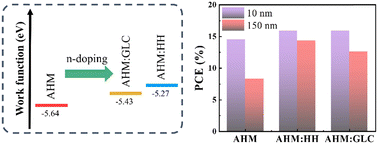Solution-processed and thickness-insensitive hole transport layer for high efficiency organic solar cells†
Abstract
Developing thickness-insensitive interface layers is still a challenge for meeting the requirements of large-scale production of high-performance organic solar cells (OSCs). Herein, we have prepared the solution-processed and thickness-insensitive MoOx hole transport layers (HTLs) with n-doping strategy. Two reducing agents with different volatility, i.e. volatile hydrazine hydrate (HH) and non-volatile glucose (GLC), were introduced as n-type dopants in precursor solutions of ammonium heptamolybdate tetrahydrate (AHM). It is confirmed that Mo(VI) is partially reduced to Mo(V) due to the n-doping effect in both of the MoOx films prepared from the AHM : HH and AHM : GLC precursor solutions. Electrical conductivities of both the AHM : HH and AHM : GLC films are significantly increased after optimization. Benefitting from the improved conductivity of the AHM : HH HTLs and the matched energy level alignments, the resultant devices demonstrate superior photovoltaic performance and outstanding tolerance to the AHM : HH thickness variation. When the AHM : HH HTL thickness is increased from 10 to 150 nm, the efficiency of resultant device is merely decreased about 10%. The devices based on the 150 nm-thick AHM : HH HTLs still offer a PCE of 14.35%, among the highest values for the OSCs with over 100 nm-thick HTLs reported to date.



 Please wait while we load your content...
Please wait while we load your content...